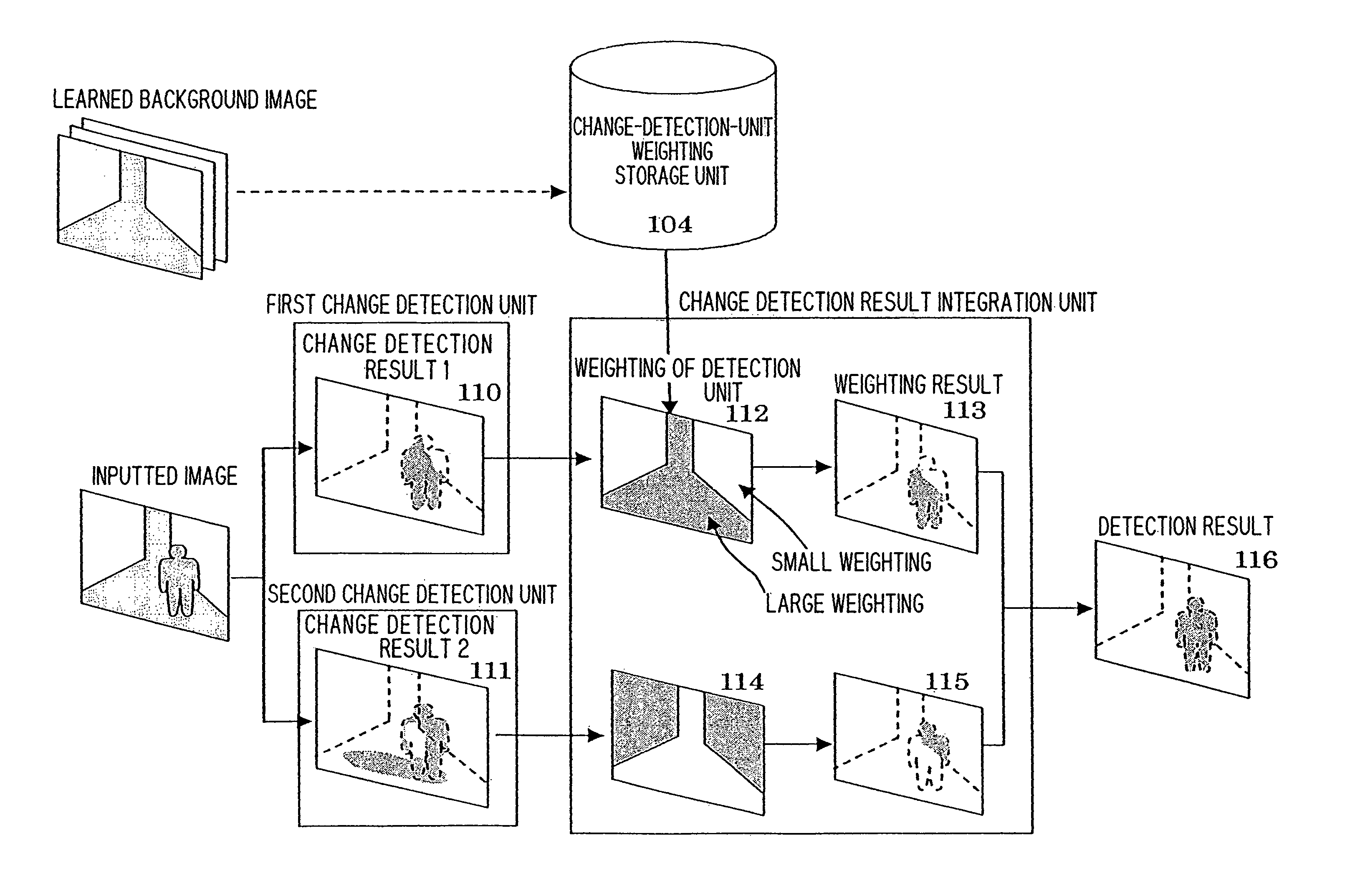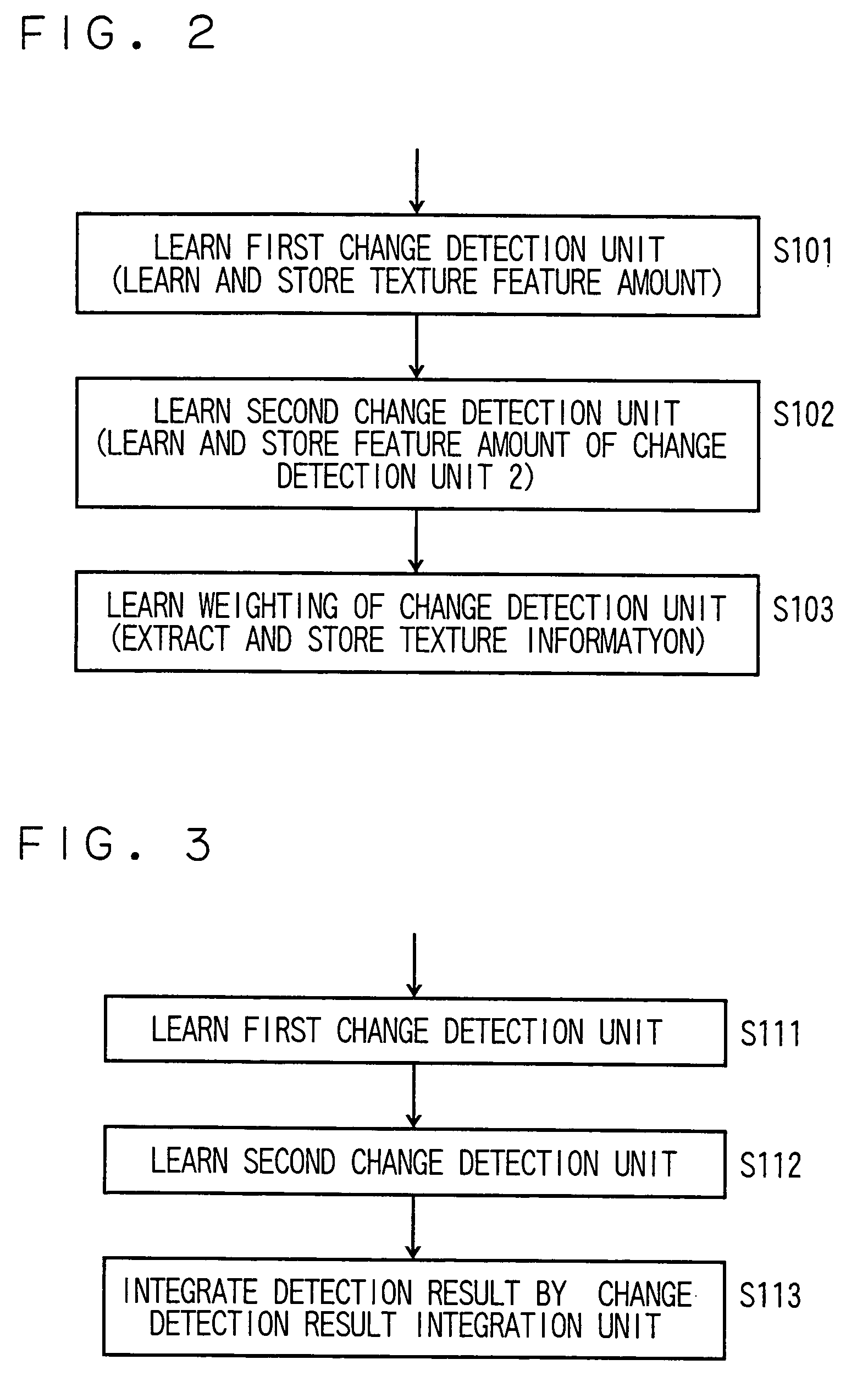Change region detection device and change region detecting method
a detection device and change region technology, applied in the direction of instruments, television systems, color signal processing circuits, etc., can solve the problems of inaccurate detection, inability to perform accurate detection, and inability to detect the whole brightness change attributed to the illumination change, so as to suppress the erroneous detection of the change region and prevent the omission of detection
- Summary
- Abstract
- Description
- Claims
- Application Information
AI Technical Summary
Benefits of technology
Problems solved by technology
Method used
Image
Examples
first embodiment
[0029]A change region detection device of a first embodiment according to the present invention is explained in conjunction with FIG. 1 to FIG. 8.
[0030]FIG. 1 is a block diagram showing the whole constitution of the change region detection device according to this embodiment, FIG. 2 is a schematic view showing a flow of learning processing, FIG. 3 is a schematic view showing a flow of detection processing, and FIG. 4 is a schematic view showing this embodiment.
(1) The Constitution of the Change Region Detection Device
[0031]The change region detection device shown in FIG. 1 includes a first change detection unit 101 which detects a change region based on texture information, a second change detection unit 102 which detects the change region based on a background differential method, a texture detecting unit 103, a change-detection-unit weighting storage unit (hereinafter, simply referred to as a storage unit) 104 and a change detection result integration unit (hereinafter, referred t...
second embodiment
[0078]A change region detection device of a second embodiment is explained in conjunction with FIG. 9 and FIG. 10.
[0079]FIG. 9 is a block diagram showing the whole constitution of this embodiment. The change region detection device shown in FIG. 9 includes a first change detection unit 201 which detects the change based on texture information, a second change detection unit 202, a texture removal unit 203, a storage unit 204, and an integration unit 205.
(1) Learning Processing
[0080]The learning processing of this embodiment is substantially equal to the learning processing of the first embodiment shown in FIG. 2 but differs from the learning processing of the first embodiment with respect to the learning processing on weighting in step S103. FIG. 10 shows a flow of the learning processing.
[0081]Steps S201, S202 shown in FIG. 10 are substantially equal to the steps S101, S102 shown in FIG. 2.
[0082]Next, in step S203, the texture removal unit 203 removes the texture from the learned b...
third embodiment
[0087]A change detection device of a third embodiment is explained in conjunction with FIG. 11 to FIG. 13.
[0088]FIG. 11 is a block diagram showing the whole constitution of this embodiment. The change region detection device shown in FIG. 11 includes a first change detection unit 301 which detects the change based on texture information, a second change detection unit 302 which detects the change based on texture information extracted from a region wider than the first change detection unit 301, a texture removal unit 303, a storage unit 304, and an integration unit 305.
[0089]Although the third embodiment has substantially the same constitution as the second embodiment shown in FIG. 9, this embodiment differs from the second embodiment with respect to a point that as the change detection unit, a change detection unit which detects the change based on the texture information extracted from the wide region is used. Accordingly, the explanation is made by focusing on portions which dif...
PUM
 Login to View More
Login to View More Abstract
Description
Claims
Application Information
 Login to View More
Login to View More - R&D
- Intellectual Property
- Life Sciences
- Materials
- Tech Scout
- Unparalleled Data Quality
- Higher Quality Content
- 60% Fewer Hallucinations
Browse by: Latest US Patents, China's latest patents, Technical Efficacy Thesaurus, Application Domain, Technology Topic, Popular Technical Reports.
© 2025 PatSnap. All rights reserved.Legal|Privacy policy|Modern Slavery Act Transparency Statement|Sitemap|About US| Contact US: help@patsnap.com



